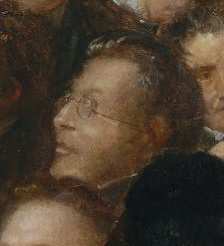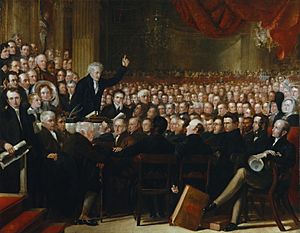Thomas Scales facts for kids
Quick facts for kids
Thomas Scales
|
|
|---|---|
 |
|
| Born | 1786 |
| Died | 1860 |
| Nationality | British |
| Education | Leeds Grammar School |
| Known for | Abolitionism |
| Spouse(s) | Christiana Simpson |
| Children | 3 survived |
Thomas Scales (born 1786, died 1860) was an important person in Britain. He worked hard to end slavery. He was the first minister (or leader) of Queen Street Chapel in Leeds. He also started a school called Silcoates School.
Contents
Thomas Scales' Story
Early Life and Education
Thomas Scales was born in December 1786 in Leeds, a city in Yorkshire, England. His father was an innkeeper and later a farmer. His mother was a strong follower of Reverend Edward Parsons.
Thomas went to several schools. He studied at the Moravian Institution at Fulneck. He also attended Leeds Grammar School.
Becoming a Minister
When Thomas was 15, he left school. He worked as an apprentice for a draper (someone who sells cloth) in Halifax. After three years, he moved to Wakefield for a year.
Then, he returned home to Leeds. He decided he wanted to become a "dissenting preacher." This meant he would lead a church that was not part of the main Church of England. In 1806, he began studying at the Hoxton Academy.
In April 1810, Thomas became a minister in a new church in Wolverhampton. In September 1810, he married Christiana Simpson. She was the daughter of Reverend Robert Simpson, who was his teacher at Hoxton Academy. Thomas and Christiana had eight children, but only three lived to be adults. He married one more time later in his life.
Leading a Growing Church
Thomas Scales was a very popular minister. His church in Wolverhampton grew quickly. It started with about 30 adults. Ten years later, it had 400 to 500 members! Because of this, they had to build a new church building. They even had to make it bigger while he was there.
In 1819, Thomas was invited to lead the White Chapel in Leeds. Again, his church grew very large. A new chapel was built in Queen Street in 1825. This new church was the biggest Independent Chapel in the north of England at that time. On the first day it opened, people donated over 400 pounds.
Fighting for Freedom
Thomas Scales was a true leader in his community. He helped start Silcoates School. This school was for the sons of ministers and missionaries. He was also a very strong supporter of the movement to end slavery. He believed in fair politics for everyone.
In 1838, Thomas Scales was chosen for an important task. He joined Lord Brougham, Joseph Sturge, and Captain Hansard RN. Together, they presented special requests to Queen Victoria. These requests were from "friends of the negro" who wanted to end slavery in the British Empire.
Thomas returned to Exeter Hall in 1840. He is shown in a famous painting by Benjamin Robert Haydon. The painting is called The Anti-Slavery Society Convention 1840. You can see Thomas Scales in the painting, wearing spectacles, next to Captain Charles Stuart.
Later Life and Legacy
Thomas Scales also helped with other important groups. He was involved in starting a society for ministers' savings. He also helped manage some charities and colleges.
He wrote and published many pamphlets and sermons. His book, Principles of Dissent, was very popular and had three editions. He was also the editor of a magazine for young Protestant Dissenters from 1833 to 1836. He left behind writings about the history of nonconformist churches in Yorkshire. These writings were used by other historians. His deep knowledge of church history made him a valuable witness in the Lady Hewley Case.
Around January 1850, Thomas Scales' eyesight began to fail. After 30 years as a minister, he resigned. He then became a chaplain and secretary at Silcoates Congregational School. Later, he moved to Gomersal and Cleckheaton.
Thomas Scales died suddenly in June 1860. He was traveling to preach a funeral sermon for a friend, Reverend John Paul, when he passed away.


